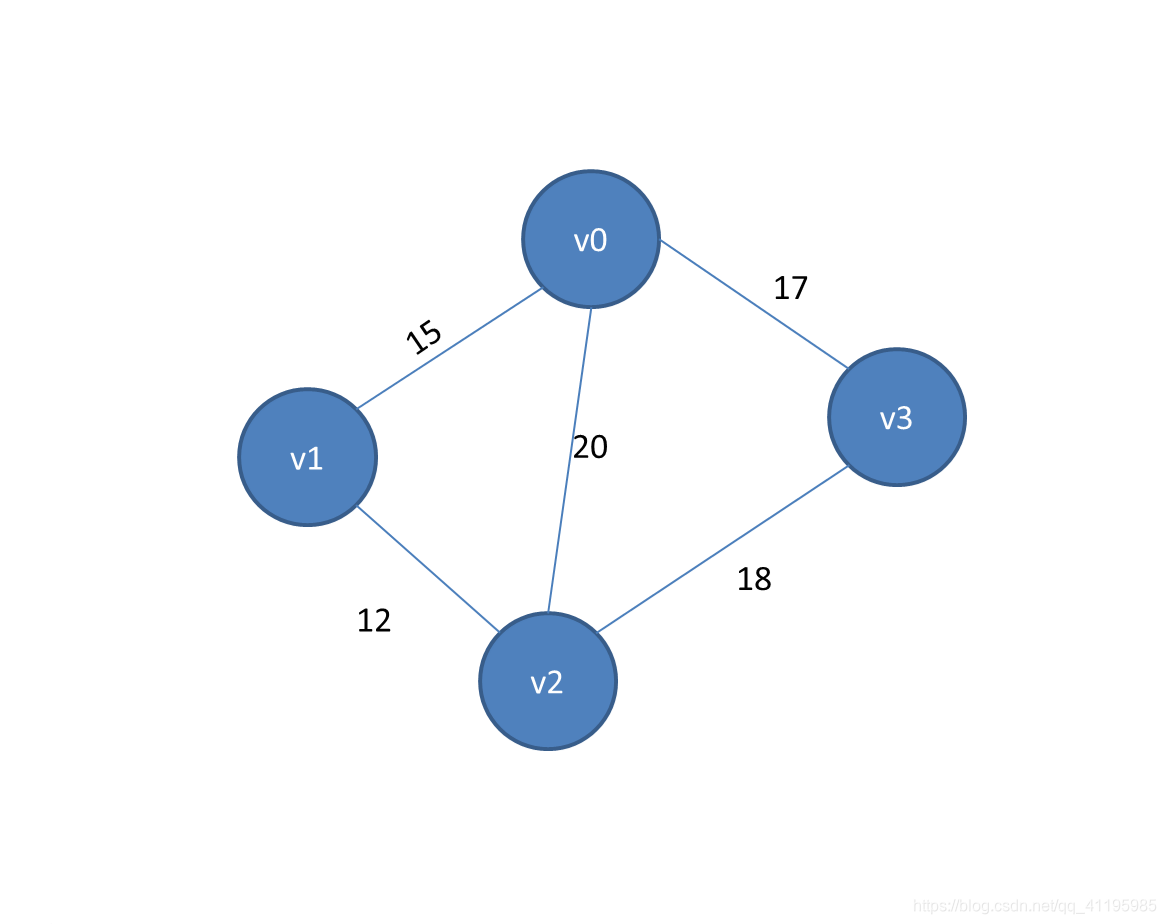带权重无向图——C++实现创建邻接表,DFS深度遍历,BFS广度遍历
2020-03-02 03:28
633 查看

邻接表如图所示
这里没有加上权重,实际数据结构是有的

代码
#include <iostream>
#include <string>
#include <vector>
#define VertexType string
typedef int EdgeType;
using namespace std;
/********链表队列LinkQueue************/
typedef int QElemType;
/*LinkQueue节点数据结构*/
typedef struct QNode
{
QElemType data;
struct QNode *next;
}QNode, *QueuePtr;
/*LinkQueue数据结构*/
typedef struct
{
QueuePtr front, rear;
}LinkQueue;
/*LinkQueue初始化*/
bool InitQueue(LinkQueue &Q)
{
QNode *temp = new QNode;
if (!temp) return false;
temp->data = -1;
temp->next = NULL;
Q.front = Q.rear = temp;
return true;
}
/*判断LinkQueue是否为空*/
bool isEmpty(const LinkQueue Q)
{
return Q.front->next == NULL;
}
/*入队操作*/
bool EnQueue(LinkQueue &Q, QElemType i)
{
QNode *temp = new QNode;
if (!temp) return false;
temp->data = i;
temp->next = NULL;
Q.rear->next = temp;
Q.rear = temp;
return true;
}
/*出队操作*/
QElemType DeQueue(LinkQueue &Q)
{
QNode *ptr = Q.front->next;
if (ptr->next)
Q.front->next = ptr->next;
else
Q.front->next = NULL;
int Data = ptr->data;
delete(ptr);
return Data;
}
/***********邻接表数据结构*************/
/*相邻接点的数据结构*/
typedef struct EdgeNode
{
int adivex; //邻接点下标
EdgeType weight; //顶点与邻接点之间的权重
struct EdgeNode *next;//指向顶点的下一个邻接点
}EdgeNode;
/*顶点的数据结构*/
typedef struct VertexNode
{
VertexType data; //顶点存储的数据类型
EdgeNode *firstedge;//指向第一个邻接点
}VertexNode,*AdjList;
/*图的数据结构*/
typedef struct
{
AdjList adjList;
int numVertexes, numEdges;
}GraphAdiList;
/*创建图*/
void CreateALFraph(GraphAdiList &G)
{
cout << "请输入顶点数和边数" << endl;
cin >> G.numVertexes >> G.numEdges;
cout << "请输入每个顶点的名称" << endl;
G.adjList = new VertexNode[G.numVertexes];
for (int i = 0; i < G.numVertexes; i++)
{
cin >> G.adjList[i].data;
G.adjList[i].firstedge = NULL;
}
int i, j ,Weight;
for (int k = 0; k < G.numEdges; k++)
{
cout << "请输入第"<<k+1<<"条边上的顶点序号和权重" << endl;
cin >> i >> j>> Weight;
/*头插法将节点接到邻接表上*/
EdgeNode *temp1 = new EdgeNode;
temp1->adivex = j;
temp1->weight = Weight;
temp1->next = G.adjList[i].firstedge;
G.adjList[i].firstedge = temp1;
EdgeNode *temp2 = new EdgeNode;
temp2->adivex = i;
temp2->weight = Weight;
temp2->next = G.adjList[j].firstedge;
G.adjList[j].firstedge = temp2;
}
}
/*输出邻接表*/
void Display(const GraphAdiList G)
{
for (int i = 0; i < G.numVertexes; i++)
{
cout << G.adjList[i].data << "->{";
EdgeNode *ptr = G.adjList[i].firstedge;
while (ptr)
{
cout << " [" << ptr->adivex<<","<<ptr->weight<<"]";
ptr = ptr->next;
}
cout << " }" << endl;
}
}
void DFS(GraphAdiList G, int i,vector<bool> &visited)
{
visited[i] = true;
cout << G.adjList[i].data<<" ";
EdgeNode *ptr = G.adjList[i].firstedge;
while (ptr)
{
if (!visited[ptr->adivex])
DFS(G, ptr->adivex,visited);
ptr = ptr->next;
}
}
void DFSTraverse(GraphAdiList G, vector<bool> &visited)
{
for (int i = 0; i < G.numVertexes; i++)
visited[i] = false;
/*如果是连通图就不必循环*/
for (int i = 0; i < G.numVertexes; i++)
{
if (!visited[i])
DFS(G, i, visited);
}
/*DFS(G, i, visited);*/
}
void BFSTraverse(GraphAdiList G, vector<bool> &visited)
{
LinkQueue Q;
InitQueue(Q);
for (int i = 0; i < G.numVertexes; i++)
visited[i] = false;
for (int i = 0; i < G.numVertexes; i++)
{
if (!visited[i])
{
visited[i] = true;
cout << G.adjList[i].data << " ";
EnQueue(Q, i);
while (!isEmpty(Q))
{
int index = DeQueue(Q);
EdgeNode *ptr = G.adjList[index].firstedge;
while (ptr)
{
if (!visited[ptr->adivex])
{
visited[ptr->adivex] = true;
cout << G.adjList[ptr->adivex].data << " ";
EnQueue(Q, ptr->adivex);
}
ptr = ptr->next;
}
}
}
}
}
int main()
{
GraphAdiList Graph;
CreateALFraph(Graph);
vector<bool> visited(Graph.numVertexes);//定义访问数组
cout << "邻接表如下:" << endl;
Display(Graph);
cout << "深度遍历" << endl;
DFSTraverse(Graph, visited);
cout <<endl<< "广度遍历" << endl;
BFSTraverse(Graph, visited);
system("pause");
}
测试效果

开发环境:Visual Studio 2017
参考书籍:《大话数据结构》
- 点赞
- 收藏
- 分享
- 文章举报
 qq_41195985
发布了10 篇原创文章 · 获赞 2 · 访问量 1521
私信
关注
qq_41195985
发布了10 篇原创文章 · 获赞 2 · 访问量 1521
私信
关注
相关文章推荐
- C++ 无向图 邻接表创建 广度遍历 深度遍历
- 邻接表深度和广度遍历DFS_BFS.c
- 深度遍历(DFS)与广度遍历(BFS) (C语言实现)
- 数据结构-图-邻接表深度和广度遍历DFS_BFS
- 邻接表深度优先和广度优先遍历(DFS和BFS)
- BFS_DFS深度广度优先C++实现。
- 大话数据结构 code 第七章 04邻接表深度和广度遍历DFS_BFS
- 图的深度优先和广度优先遍历(图以邻接表表示,由C++面向对象实现)
- [置顶] 图:图的邻接表创建、深度优先遍历和广度优先遍历代码实现
- 邻接表实现--图的深度优先遍历DFS和广度优先遍历BFS
- 【数据结构】邻接表深度和广度遍历DFS_BFS
- 图的广度遍历(BFS)与深度遍历(DFS)
- 数据结构之——用C++实现邻接表的DFS与BFS
- 图的遍历 DFS(深度优先),BFS(广度优先)
- 【数据结构】拾遗(一):图的邻接矩阵创建以及其深广度遍历C++实现
- 邻接矩阵实现--图的深度优先遍历DFS和广度优先遍历BFS
- 图的存储及遍历 深度遍历和广度遍历 C++代码实现
- 基于邻接表的无向图的深度广度遍历实现
- python遍历文件夹——深度优先(DFS)/广度优先(BFS)
- 图的遍历之-DFS深度优先遍历C++实现
